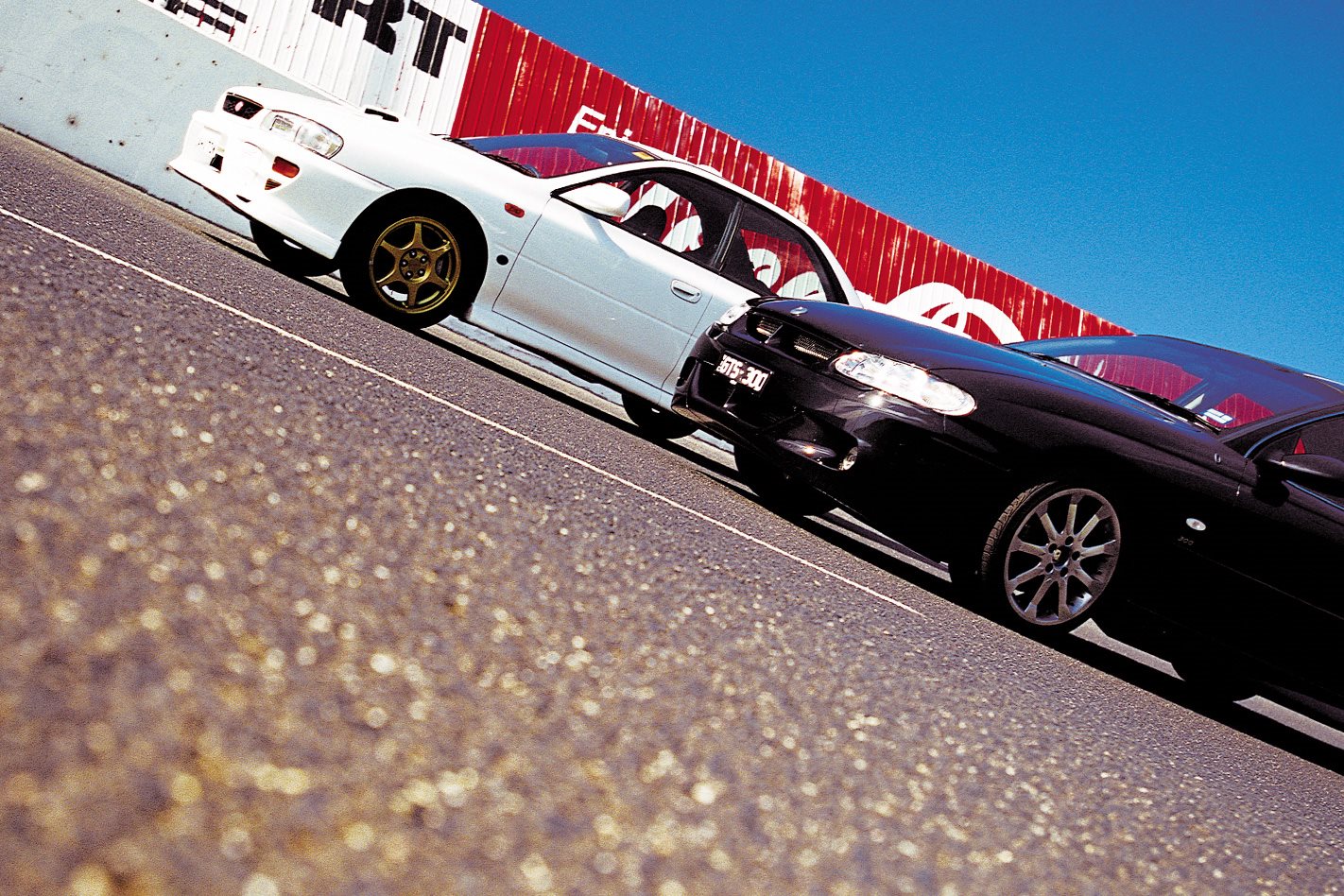Lets not fiddle with each other’s tockleys here. This comparison doesn’t deserve to exist on so many levels it’s almost funny.
This story first appeared in the May 2000 issue of MOTOR.
You won’t catch a wannabe HSV GTS owner wasting a sideways glance at a WRX STi. Simple as that. Meanwhile, the type of punter who’s likely to be shelling out for the Sube is gonna think a GTS is a shed with headlights. Equally simple.
The two don’t compare on price, theyre not even remotely technically similar and who gives a monkey’s about standard equipment anyway?
So, having established they’re not marketplace competitors and have about as much in common as Mother Teresa and Iron Mike, what the hell are we doing here? Simple, it’s a speed thing. If I need to explain, consider yourself banished to your stamp collection.
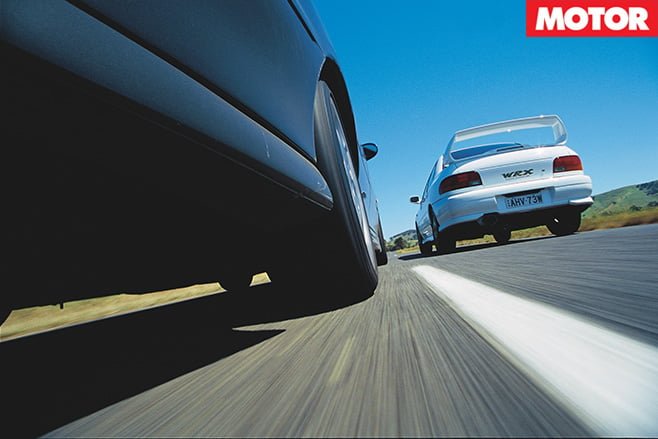
With the shift to the Gen III V8 last year, HSV also stepped up to the mark. But even with the 250kW the R8 was packing, the local hero was always just that little bit off the pace.
Not any more. With the 2000 GTS model, HSV has lobbed one straight into the backyards of M-Haus, AMG and Fuji Heavy. And now, having booted over their rubbish bins, pinched their milk money and blown up their mail boxes, HSV is coming round to roger their puppy dogs.
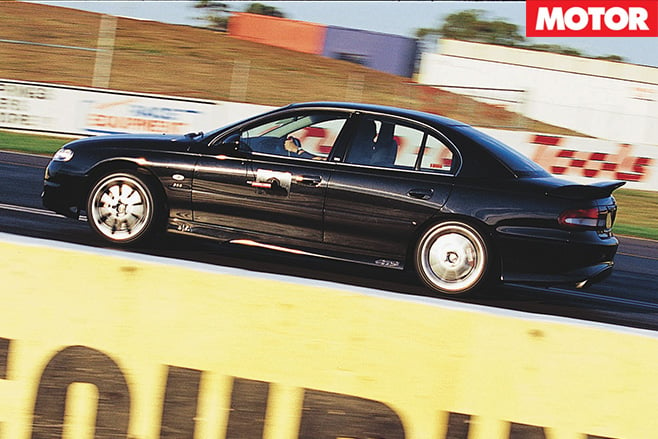
The Rex, meanwhile, is wallpaper these days. Unless you really know your stuff, the chunderous pink badges are just that. And since so many WRXs run radical wheel and tyre packages, the STis don’t even stand out any more.
It’s still equal parts dumpling and trinket, and the four-door bodyshell makes it even more invisible. But the wallflower stuff stops where the spec sheet begins, and the STi is a purposeful upgrade over the standard WRX (itself no soft-cock).
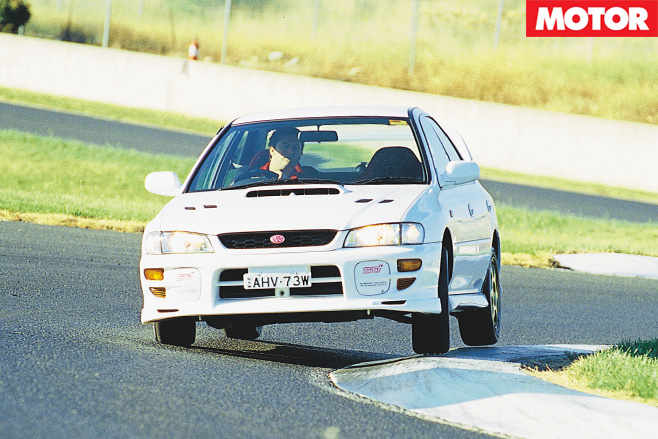
Underneath you get inverted strut suspension and shorter 4.44:1 overall gearing. Throw in a close ratio five-speed ‘box, a carbon-fibre strut brace and whitefaced gauges and you’ve got yourself an STi.
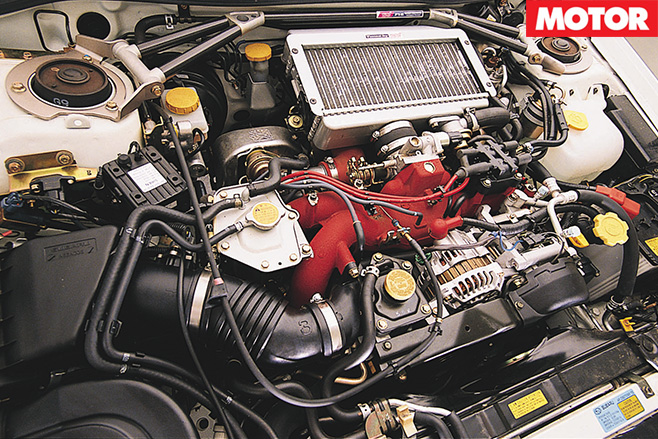
The GTS, meanwhile, also represents a serious upgrade of an already serious tool. The engine is one thing but, obviously, HSV had to put in plenty of hours to make sure the whole car worked as a team and not as a life support system for the motor.
So, you get a tougher cliff centre to cope with the shorter HSV gearing, with each propshaft handmatched and balanced before being shipped to Clayton. Hydratrak makes a come-back with the GTS, too, and the clever slippery cliff works a treat.
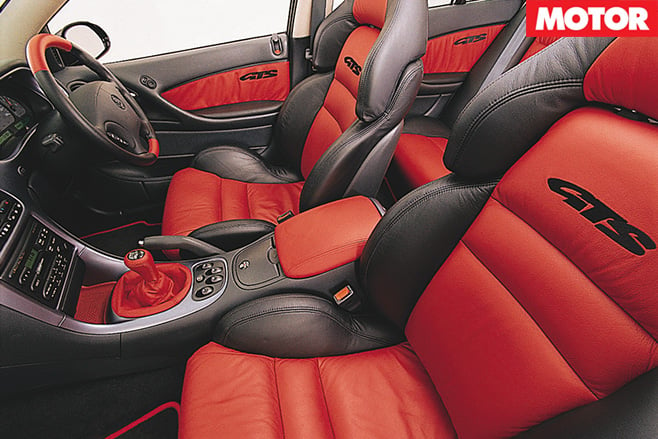
In the 250kW cars, HSV managed to get away with a stiffer bush, but 300kW is another story. Expect to see the extra link on all Commodores next model change.
Extracting 300kW from almost six litres doesn’t require outright rocket science, but you’ve still got to be careful to make sure it’ll run on pump gas and not cook itself on the way to the shops.
Perhaps most surprising is the fact the entire bottom end of the all-alloy mill is as Chevrolet intended. Topside, there’s a bit more going on with the heads virtually hand-built, the ports CNC machined for better flow and different valves fitted.
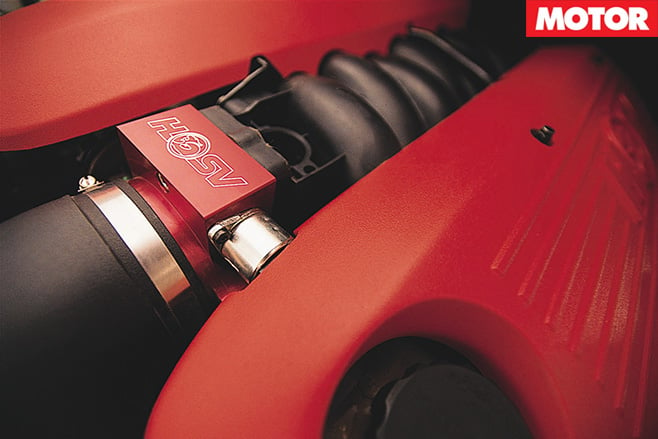
The end result is that wonderful power figure of 300kW delivered at 6000rpm and an equally impressive 510Nm torque figure. The only problem there is where the torque peaks, and in this case it maxxes out at a high 4800 rpm; a figure that’s all the higher when you consider we’re talking about 5.7 litres of prime rib.
The high peaks are a direct result of HSV stretching the rev range to get the big numbers. And since the Gen III has already proved itself to be a top-endy sort of gadget, that could mean trouble for driveability, even if it doesn’t compromise the thing against the stop watch.
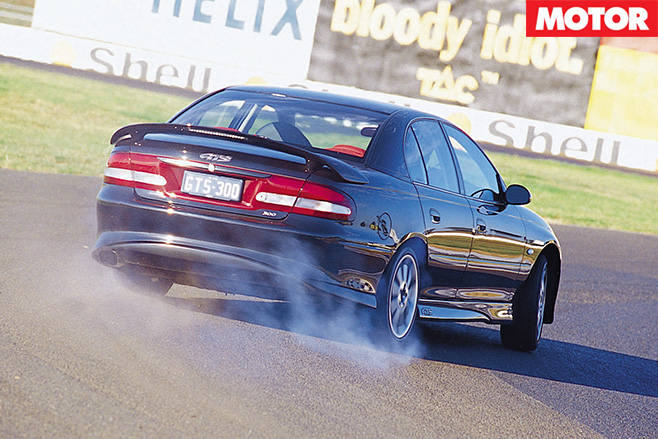
Launching the GTS is one big balancing act. Too many revs equals wheelspin, smoke and eight shades of slow. Like a lot of pokey cars, you need to match the rev (and, therefore, power) against how fast you dump the clutch and how much grip the tyres are generating.
But get it right and the big mutha sprints off the line and yodels right through first gear till the shift light on the dash blinks at you and you grab for another ratio. But that’s also where the inherently slow-changing driveline catches up with you because it’s almost impossible to make those lightning changes that super-quick times are generally made of.
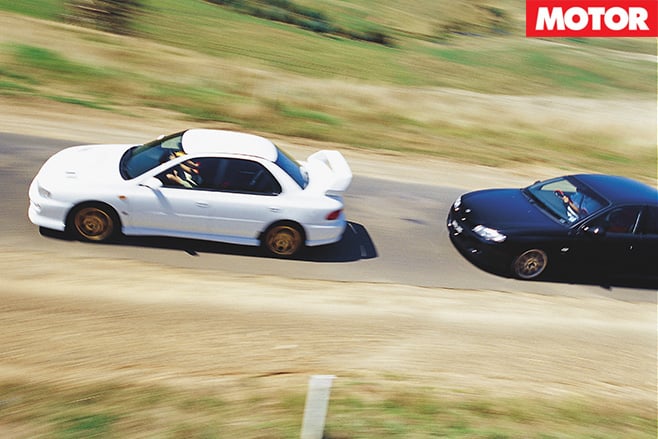
Last month the GTS snorted down the line, clocking a 13.57-second quarter mile run. A slightly slower take-off and slower gear changes cost the big HSV this time, just managing to break the 14-second barrier.
Getting the Rex off the line is, by comparison, a piece o’ piss. You’ve got to remember the clutch is probably the weak link in the chain, but if you can bear to slip it a bit, the WRX launches super hard.
Once you’ve fed the clutch right out, it’s just a case of hanging on and pointing it down the strip, safe in the knowledge that all-wheel drive won’t allow it to break traction or slew around during gearshifts.
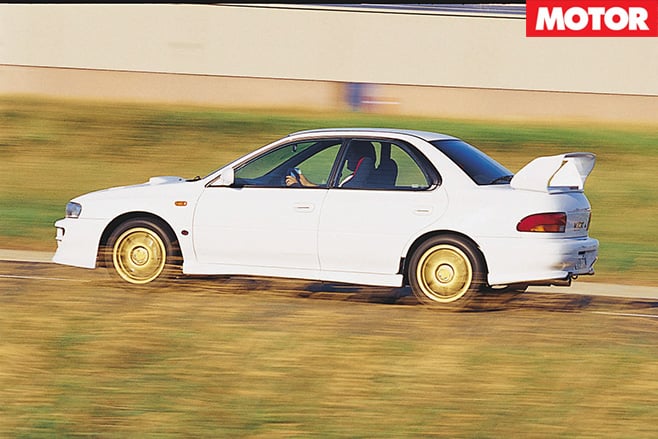
Look at the figures and you’ll see where the traction offered by all-wheel drive gives Subaru its edge. The GTS is actually quicker to 160km/h (12.55sec) and covered 335 metres. The STi took slightly longer to reach the old imperial ton (13.06sec) but had traversed 378 metres.
Still, for such a big car the GTS is mighty quick,. And we mean it when we say big. As in heavy. It looks substantial and feels slightly ponderous through the steering wheel. It even smells heavy.
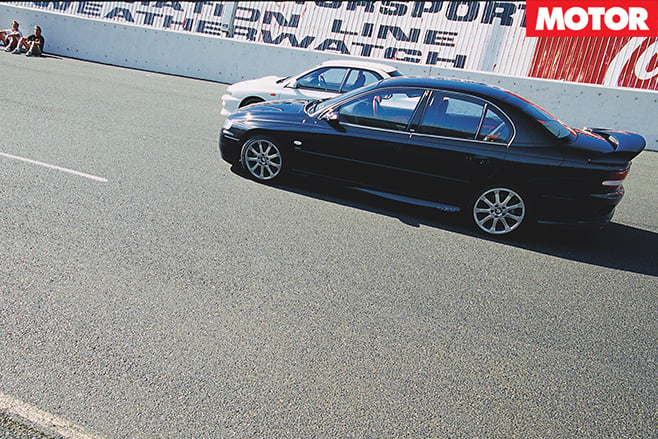
Bang the shifter through another notchy gate, slide out the clutch and there’s the sensation of many, weighty, fast-moving parts all lining up again and taking a bit of time to do it. While the gear changing process barely alters the Subaru’s mood, it’s up there with turning 21 in the HSV.
Of course, the mass sensation is part and parcel of engineering something that will cope with a 300kW onslaught over many years and many kilometres. But it also means the HSV isn’t instantly cuddly and reassuring like the Rex is.
Jump in the GTS and you’re always being reminded just how big the bugger is, from the view in each side mirror to the vast expanse of plastic that is the dashboard.
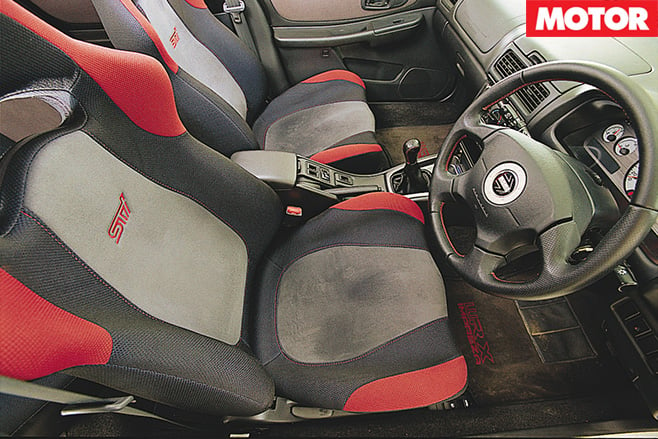
It doesn’t feel threatening, doesn’t wag its finger at you, doesn’t belittle your abilities and doesn’t try to shag your leg. User-friendliness like this is rare indeed.
The GTS scores points for its superior ride over just about any kind of irregularity and a quieter ride into the bargain, which was spoilt only by the orchestra of creaks and groans from the bodyshell and driveline.
The iffy ride of the WRX, meanwhile, only serves to remind us that the thing is based on a pretty basic device in the first place. But it is agile. In contrast, the HSV is a point-and-shoot kind of contraption thanks to the dead steering that has you wondering exactly where the wheels are pointing sometimes and the sheer mass of it which you can feel moving around on its tread patterns.
The Sube feels like it weighs nothing by comparison and almost seems to corner better the harder you go. There’s a bit of initial understeer that the HSV doesn’t have, but after that the Rex hooks up hard and fairly blurts out the exit looking for more corners.
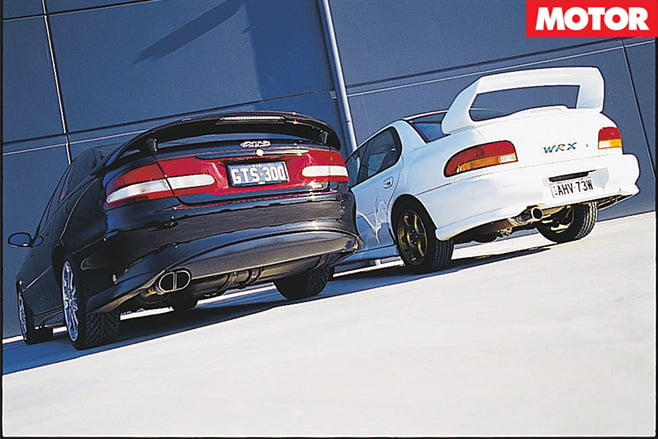
Brakes? A win to the local boy, although it’s a qualified one because the Subaru’s anchors are pretty damn good themselves. But the pedal is a bit wooden and, ultimately, they don’t have the unbelievable retardation of the GTS.
By now you’re thinking the Rex has got this in the bag, right? Exactly, and while it proves that big stomp doesn’t necessarily overcome an agile chassis and brilliant grip, we were left wondering whether maybe our test Rex was perhaps a little too good.
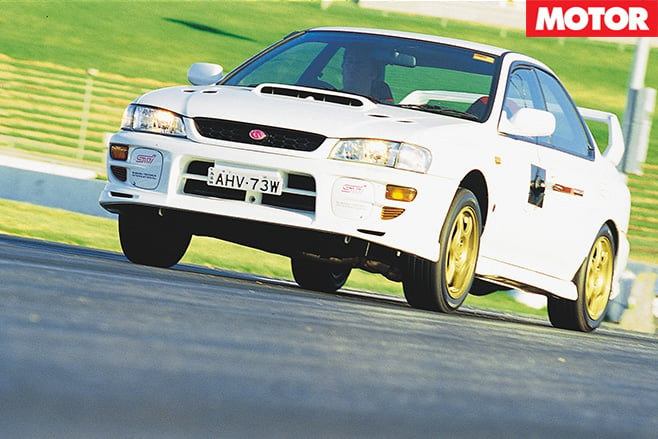
Basically, for all that it’s packing 300kW, the mass of the GTS plays against it both in a straight line and in the swervery. The STI, meanwhile, uses its agility and phenomenal grip to simply murder the big guy on the sort of tight, twisting stuff that cars like this are made for.
On the Nullarbor, different story. Oh, and the Subaru’s 30K cheaper. D’oh!
| FUN FACTS | ||
| u00a0 | HSV GTS | Subaru Impreza WRX STi |
| Body | four-door sedan | four-door sedan |
| Drive | rear-wheel | all-wheel |
| Engine | front-mounted 5. 7-litre 16-valve pushrod VB | front-mounted 2.0-litre DOHC 16-valve turbocharged intercooled horizontally opposed four |
| Power | 300 kW @ 6000 rpm | 206 kW @ 6500 rpm |
| Torque | 510 Nm @ 4800 rpm | 353 Nm @ 4000 rpm |
| Compression ratio | 9.8:1 | 8.0:1 |
| Bore x stroke | 99 x 92 mm | 92 x 75 mm |
| specific power | 52.6 kW per litre | 103 kW per litre |
| kerb weight | 1700 kg | 1270 kg |
| weight/power | 5.67 kg/kW | 6.17 kg/kW |
| transmission | six-speed manual | five-speed manual |
| final drive | 3.9:1 | 4.44:1 |
| suspension | MacPherson struts, coil springs, anti-roll bar (f); independent by multi-link semi-trailing arms, coil springs, anti-roll bar (r)u00a0 | MacPherson struts, coil springs, anti-roll bar (f); independent by struts and dual lateral links, coil springs, anti-roll bar (r)u00a0 |
| L/W/H | 4884/1842/1450 mm | 4350/1690/1405 mm |
| wheelbase | 2793 mm | 2520 mm |
| track | 1569 mm (f); 1587 mm (r) | 1470 mm (f); 1460 mm (r)u00a0 |
| brakes | 343 mm cross-drilled, ventilated discs (f); 315 mm cross-drilled and ventilated discs (r), ABS | 294 mm ventilated discs (f(); 266 mm ventilated discs (r), ABS |
| wheels | 18 x 8-inch alloys | 16 x 7-inch alloy |
| tyres | Bridgestone S-02 235/40 ZR18 | Bridgestone RE010, 205/50 R16 |
| fuel | 75 litres, PULP | 50 litres, PULP |
| price | $90,500 | $62,500 |
| FAST FIGURES | ||
| 0-10 | 0.57 | 0.28 |
| 0-20 | 1.03 | 0.6 |
| 0-30 | 1.53 | 0.89 |
| 0-40 | 1.97 | 1.24 |
| 0-50 | 2.47 | 1.68 |
| 0-60 | 2.9 | 2.26 |
| 0-70 | 3.55 | 3.07 |
| 0-80 | 4.35 | 3.69 |
| 0-90 | 5.01 | 4.46 |
| 0-100 | 5.81 | 5.14 |
| 0-110 | 6.83 | 6.48 |
| 0-120 | 7.86 | 7.3 |
| 0-130 | 8.8 | 8.53 |
| 0-140 | 9.77 | 9.72 |
| 0-150 | 11.3 | 10.97 |
| 0-160 | 12.55 | 13.06 |
| 0-400M | 13.99 @ 168.6 KM/H | 13.56 @ 166.9 KM/H |

